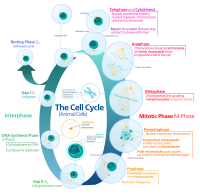
Photo from wikipedia
Summary Eukaryotic cells position the nucleus within the proper intracellular space, thereby safeguarding a variety of cellular processes. In fission yeast, the interphase nucleus is placed in the cell middle… Click to show full abstract
Summary Eukaryotic cells position the nucleus within the proper intracellular space, thereby safeguarding a variety of cellular processes. In fission yeast, the interphase nucleus is placed in the cell middle in a microtubule-dependent manner. By contrast, how the mitotic nucleus is positioned remains elusive. Here we show that several cell-cycle mutants that arrest in mitosis all displace the nucleus toward one end of the cell. Intriguingly, the actin cytoskeleton is responsible for nuclear movement. Time-lapse live imaging indicates that mitosis-specific F-actin cables possibly push the nucleus through direct interaction with the nuclear envelope, and subsequently actomyosin ring constriction further shifts the nucleus away from the center. This nuclear movement is beneficial, because if the nuclei were retained in the center, unseparated chromosomes would be intersected by the contractile actin ring and the septum, imposing the lethal cut phenotype. Thus, fission yeast escapes from mitotic catastrophe by means of actin-dependent nuclear movement.
Journal Title: iScience
Year Published: 2021
Link to full text (if available)
Share on Social Media: Sign Up to like & get
recommendations!